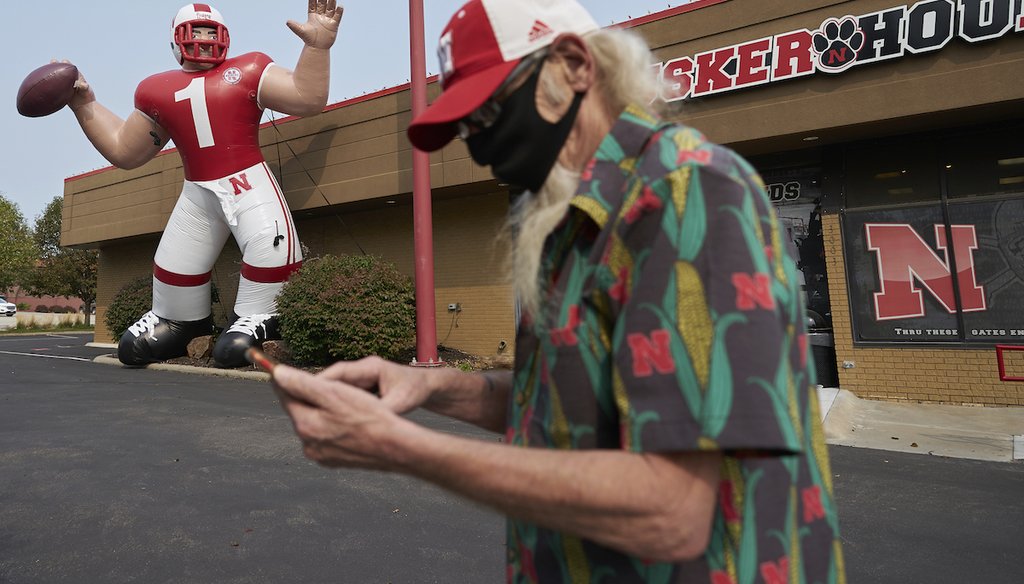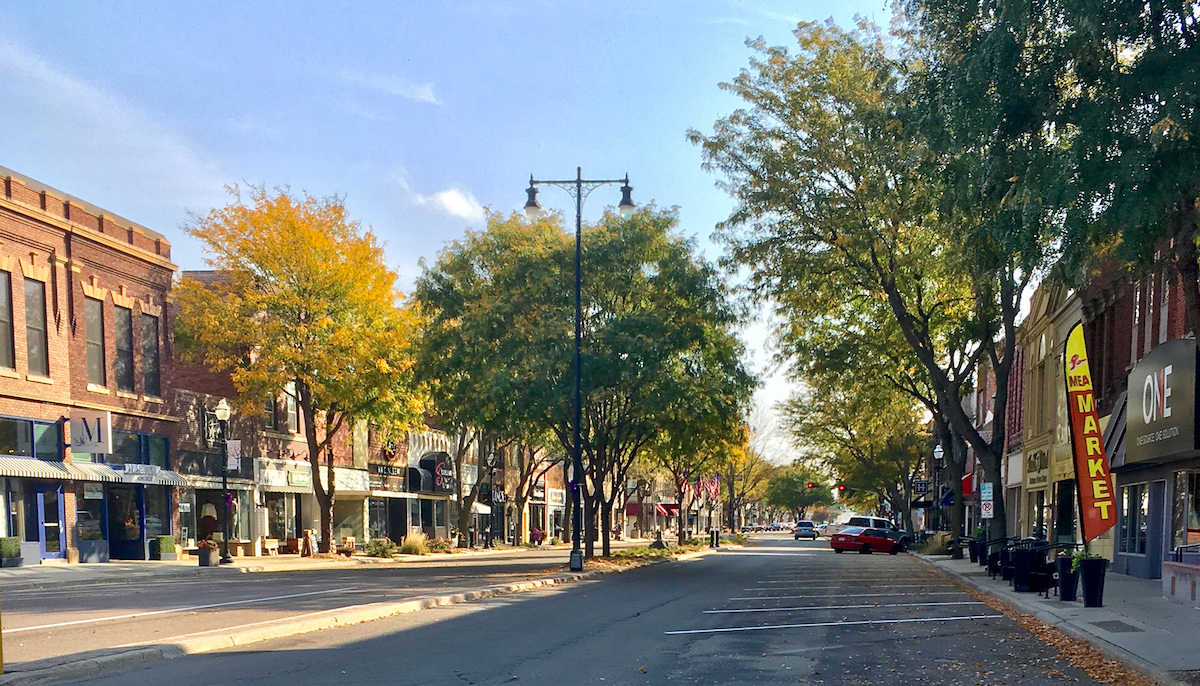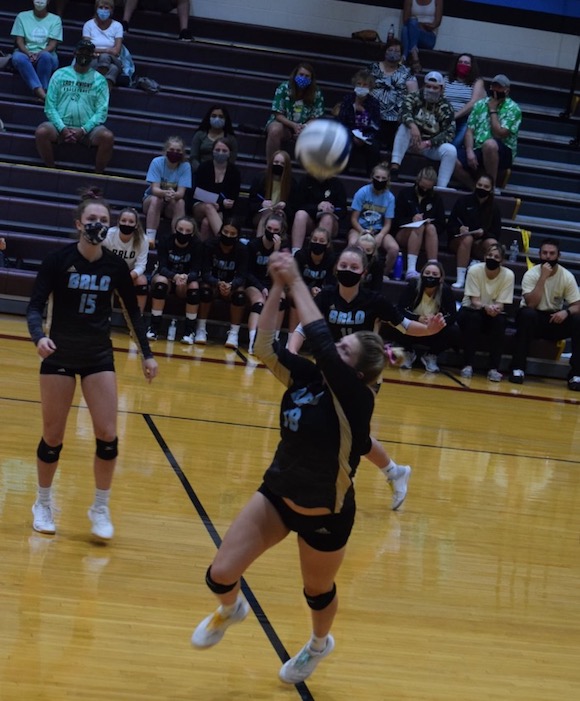Stand up for the facts!
Our only agenda is to publish the truth so you can be an informed participant in democracy.
We need your help.
I would like to contribute

A fan stops to take a picture of a giant inflatable football player standing in front of the Husker Hounds sports apparel store in Omaha, Neb. Omaha has a mask mandate, but the state as a whole doesn’t. (AP Photo/Nati Harnik)
If Your Time is short
-
For the first time, the coronavirus is hitting smaller cities and towns, and Nebraska has been hit as hard as any.
-
Health professionals seek a mask mandate, as neighboring states have done. But the move faces stiff opposition from many, including the Republican governor.
-
To address surging cases and hospitalizations, some local officials are taking steps the governor won’t.
As the virus surges nationwide, one by one, governors who once resisted calls for stricter coronavirus measures have relented. Since November, Republican governors in North Dakota, Utah and Iowa have imposed tighter limits on gatherings and mandated masks.
But in a few statehouses, a raging virus is still seen as insufficient reason to dictate something as personal as a mask. Businesses like hair salons and restaurants must follow new rules, and some rules involve masks. But for the public at large, these states rely on individuals to decide to do the right thing.
Nebraska is one of the emerging hotspots where the politics of coronavirus policy have become more complicated. The virus’ second wave has come crashing down on people and places far removed from where the pandemic first appeared in the state. But despite pleas from health care providers, the governor stands firmly against a mandate, leaving it to local governments, businesses, school districts and individuals to devise their own approaches.
‘Our ICUs are all full’
In the spring, while states on the coasts were seeing widespread COVID-19 outbreaks, Nebraska’s was more concentrated. The coronavirus struck meatpacking plants in communities home to a large share of Nebraska’s Hispanic residents. It also threatened nursing homes.
Now, COVID-19 is in smaller communities, and afflicting people across the spectrum.
At the beginning of October, the state averaged about 470 new cases a day. By mid-November, that had shot past 2,300. Hospitals face a flood of COVID-19 patients.
"We’re pretty much full all the time now," said Russ Gronewold, the CEO of Bryan Health, a major medical center in Lincoln, Neb. "Our ICUs are all full and we’ve converted entire wards over to COVID-19 care."
Gronewold and other health care providers are caught in a tug-of-war that’s playing out across the state over how to rein in the pandemic as the footprint of the virus moves beyond the hotspots that were hit in the first wave.
"People can’t just say, ‘Oh, that person was old, or they were already sick,’" said Josh Moenning, the mayor of Norfolk, Neb. "We’re seeing younger, otherwise healthy people get very sick and some die, and that’s changed the local discussion pretty dramatically."
Republican Gov. Pete Ricketts urges everyone to wear a mask. In news conferences, he backs that up with a cavalcade of ordinary people telling their stories of how they barely survived COVID-19. It’s the public health version of Scared Straight (the programs once used to deter kids from crime and drugs) with a strong dose of community responsibility thrown in.
But he won’t require masks, saying mandates breed resistance, not compliance.
COVID-19 safety measures: A work in progress
About 160 miles west of Lincoln on the Platte River, the city of Lexington is home to two processing plants, one for meat and the other for animal byproducts. Hispanic workers dominate the production lines. They and their families account for over 60% of Lexington’s population.
When COVID-19 first came to Nebraska, it spread through factories like the ones in Lexington. Initially, plant managers resisted calls to keep workers separated, conduct testing and provide masks.
As with the rest of the U.S., COVID-19 has fallen particularly hard on Hispanic residents. They are 11% of Nebraska’s population but account for 27% of cases and 18% of deaths.
As workers fell sick or died, and some plants were forced to shut down, the companies changed their approach. State Sen. Tony Vargas, D-Omaha, said progress is mixed.
"Many of them have put in more measures to help their employees, some doing more and some doing less," Vargas said. "Some of the plants are not upholding their internal policies on mask wearing. We hear stories that if people test positive and don’t have symptoms, they are given the OK to come back."
COVID-19 safety in the plants remains a work in progress. Based on data from the University of Nebraska and the Covid Tracking Project, the use of masks and distancing appears to have helped. Cases and hospitalizations among Hispanics fell by at least 50% from their high point in the summer.
The community spread that is now hitting hard among whites has also led to a rise among Hispanics. On one hand, the impact is not falling so disproportionately on Hispanics anymore. On the other hand, many, many more people are suffering.
Local deaths change local attitudes
Norfolk, a city of about 25,000 people, is a two-hour drive northwest of Omaha. On Oct.1, COVID-19 killed local photographer Paul Filsinger. Weeks later, the Norfolk Daily News told the story of how Filsinger, 60, caught the virus while working at a wedding reception. Few guests wore masks. Typically, he wore a mask. That day, he didn’t.
Filsinger led an active life. Right after the wedding, he went camping in Wyoming. Within 10 days, with a persistent cough and his blood oxygen levels dropping, he checked in to his local hospital. A month later, he was gone.
"People believe masks don’t help, but right now, masks will buy us some time against COVID," his fiancee told the newspaper.
Moenning, Norfolk’s mayor, welcomed that blunt message. He told PolitiFact he’s been frustrated by the hardline rejection of masks and other precautions. He finds the politicization of masks "unhelpful." But he understands why that attitude could last.
"For a lot of people, the virus hadn't yet hit close to home," Moenning said. "But more and more that's starting to change.,"
The downtown district in Norfolk, Neb. (Norfolk Area Visitors Bureau)
Smaller communities have a particular vulnerability, said David Brett-Major, a University of Nebraska Medical Center epidemiologist.
"We forget the way personal dynamics play out in small towns," Brett-Major said. "You see the same people at the store and church. From a mixing perspective, once you introduce a threat into that environment, it moves very quickly."
In the past 30 days, the number of cases in the county that includes Norfolk more than doubled, from 1,000 to 2,600.
Schools pave the way
Moenning and other local leaders say masks have become more common. That’s partly due to fear of the virus, but also, they say, due to the schools. The schools made a winning case for masks that eased people into the practice.
In-person teaching is the rule in Nebraska schools, and in many places, that comes with the requirement to wear masks.
In districts like Bancroft-Rosalie Community Schools, 45 miles due east of Norfolk, some parents pushed back. But Superintendent Jon Cerny said two arguments won over reluctant households.
"They can handle a day or two of teaching their kids at home," Cerny said. "But nobody wants to go back to a month at a time. It's a lot of stress."
Parents also began to don masks, because they wanted to see their kids play basketball and volleyball.
Volleyball match with masks for both players and fans at Bancroft-Rosalie Community Schools in Bancroft, Neb. (Rhonda Hansen)
"People respond to their sports here in Nebraska," Cerny said. "We wanted to give kids the opportunity to play, and people understood that if you want to keep them safe, you either eliminate fans or you wear a mask. People got that."
In Norfolk, Moenning aimed to put a mask requirement into effect in all public indoor spaces. The move required buy-in from the city council. To get there, he enlisted the help of the city’s two largest employers, the hospital and the steel and metal company Nucor.
"People from the business community have been talking to members of the city council," Moenning said. "They know that if we don’t get our numbers down, we could face another round of shutdowns. If we want to keep businesses open and maintain a strong economy, we need to do this."
A few days before the vote in Norfolk, the small cities of Kearney and Beatrice adopted mask mandates. On Nov. 23, the Norfolk council passed the measure unanimously, 7-0.
The politics of hospitals on the brink
At the statehouse in Lincoln, mask mandates remain a political lightning rod.
In early November, social media savvy physicians began tweeting a graphic urging Ricketts, the governor, to act now.
In response, the governor’s spokesman offered his own tweets, pointing out that the doctors who tweeted supported Joe Biden. One doctor fired back, "These are not political posts. They are a plea for our leaders to listen to the medical experts and help our community."
At Bryan Health, CEO Gronewold said his hospital has been flooded with patients from the nearly 50 rural communities the hospital serves.
"We’ve decided we need to get more forthright in getting in front of people and saying what we need," said Gronewold.
The disease has sidelined over 100 staffers at Bryan Health, including 39 bedside nurses. Some were exposed to COVID-19 and must quarantine. Others have tested positive.
"Lincoln has a mask mandate," Gronewold said. "They don’t have that in most outlying areas, and we need compliance."
The head of the state’s leading infectious disease center has also called for a statewide mask mandate.
In his most recent news conference, Ricketts warned that the state’s hospitals would soon reach a critical bed shortage, and he would impose tighter rules.
A broad mask mandate is not among them.
Our Sources
Centers for Disease Control and Prevention, States, accessed Nov. 16, 2020
KTIV, Nebraska governor urges residents to voluntarily wear masks, still opposes mandate, Nov. 17, 2020
State of Nebraska, Color coded COVID measures, Nov. 13, 2020
Nebraska Governor’s Office, Gov. Ricketts, State’s Chief Medical Officer Overview Coronavirus Treatments, Nov. 17, 2020
Nebraska Governor’s Office, Gov. Ricketts Announces Phased Public Health Restrictions Tied to Coronavirus Hospitalization Rate, Nov. 13, 2020
State of Nebraska, Covid-19 dashboard,Nov. 14, 2020
State of Nebraska, Covid-19 dashboard,June 29, 2020 via Internet Archive
Nebraska Medicine, I’m sorry this post is so dark, but we need to get the word out about the COVID-19 situation in Nebraska, Nov. 11, 2020
Omaha World-Herald, COVID surges in Dakotas are warning of what may happen in Nebraska, Iowa, Nov. 15, 2020
Norfolk Daily News, Norfolk, Columbus hospitals near capacity for COVID-19 patients, Nov. 17, 2020
Norfolk Area Economic Development Council, Norfolk, accessed Nov. 18, 2020
Lincoln Journal Star, Ricketts says Nebraska is approaching renewed COVID-19 restrictions, Nov. 23, 2020
Kaiser Family Foundation, With COVID-19 Cases Surging Again, States Are Taking Action, Though Current Efforts May Not Be Enough to Stop the Spread, Nov. 20, 2020
FRED, Madison County unemployment, accessed Nov. 17, 2020
Covid Tracking Project, Nebraska hospitalization, accessed Nov. 17, 2020
NBC News, Nebraska governor says mask mandates 'breed resistance', Nov. 17, 2020
Darling Ingredients, Annual report, Dec. 28, 2019
ABC 8 News, New restrictions in effect after COVID cases soar in Lincoln, Nov. 16, 2020
NBC 6 News, Ricketts reiterates possibility of COVID-19 restrictions as hospitalizations continue to rise, Nov. 16, 2020
WOWT, Ricketts spokesman calls out doctors' politics after their push for better COVID-19 response, Nov. 9, 2020
Kelly Cawcut, tweet, Nov. 6, 2020
Nebraska Medicine, 1,700+ Nebraska health care workers signed this letter asking for your help, Nov. 17, 2020
Johns Hopkins Coronavirus Resource Center, Nebraska, accessed Nov. 17, 2020
American Prospect, Nebraska Meatpacking Workers Continue to Struggle During the Pandemic, Aug. 11, 2020
PolitiFact, No, fight against coronavirus isn't rounding the corner, as Donald Trump said, Oct. 23, 2020
Occupational Safety and Health Administration, What is the risk to workers in the United States?, accessed Nov. 16, 2020
National Institute of Environmental Health Sciences, COVID-19 Pandemic Vulnerability Index, accessed Nov. 16, 2020
Statement, Mark Rupp, chief, Division of Infectious Diseases, University of Nebraska Medical Center, Nov. 19, 2020
Interview, Davd Brett-Major, professor, Department of Epidemiology, University of Nebraska Medical Center, Nov. 17, 2020
Interview, Tony Vargas, senator, Nebraska State Senate, Nov. 17, 2020
Interview, Brian Depew, executive director, Center for Rural Affairs, Nov. 17, 2020
Interview, Russ Gronewold, CEO, Bryan Health, Nov. 17, 2020
Interview, Jon Cerny, superintendent and elementary school principal, Bancroft-Rosalie Community Schools, Nov. 18, 2020
Interview, Gladys Godinez, community organizer, Center for Rural Affairs, Nov. 18, 2020
Interview, Josh Moenning, mayor, City of Norfolk, Nov. 18, 2020






















































